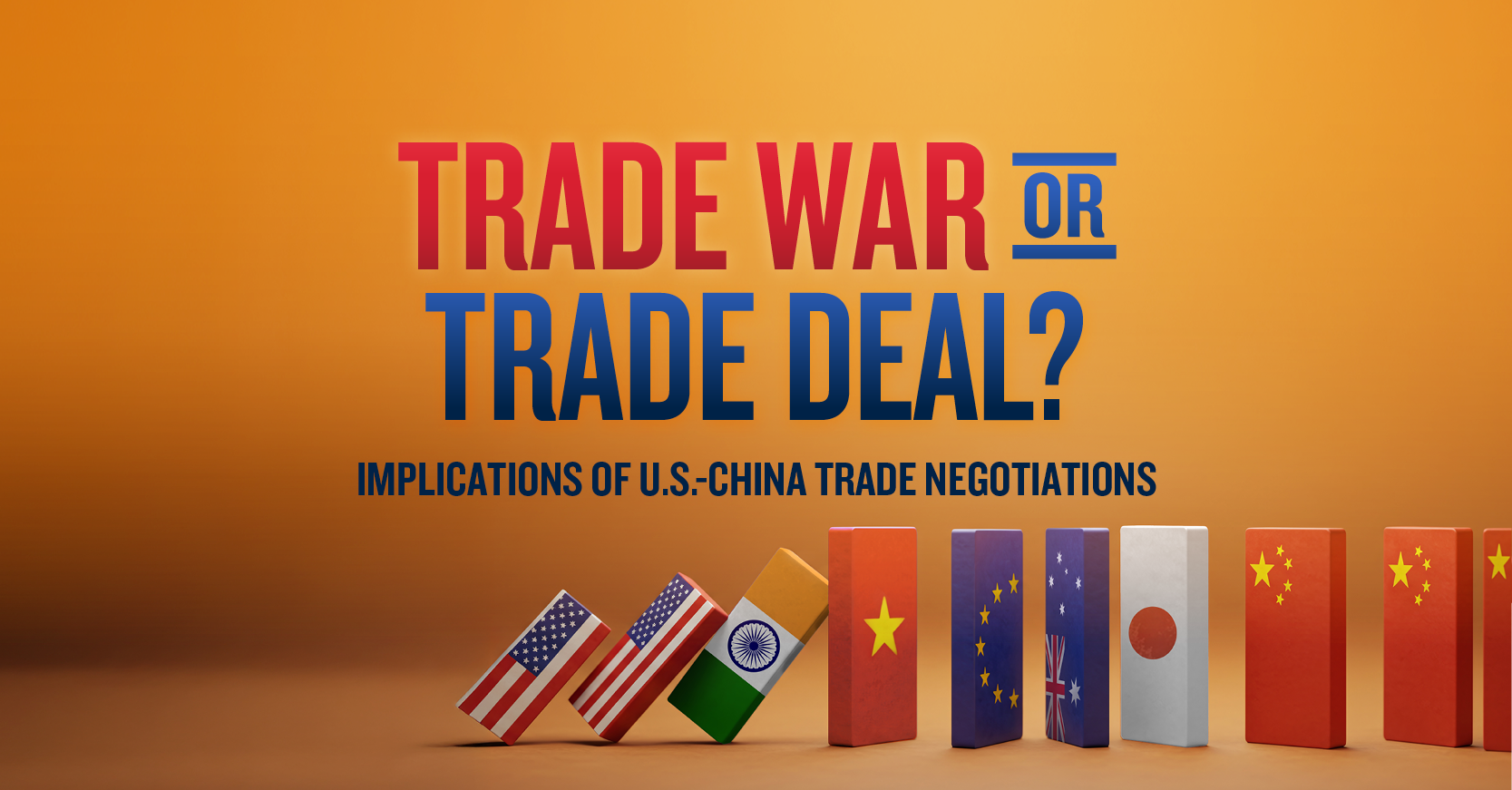As major wars unfold in Europe and the Middle East, the U.S. and China remain locked in an unrelenting competition for global supremacy. With Russia on a relative decline, the U.S.– China rivalry continues to re-shape the current geopolitical landscape. Beijing’s imperative to achieve self-sufficiency in foundational technologies and to advance its military has reinforced the U.S.' perception that China not only has the capability to "directly compete" with it, but also has the intent to replace it as the dominant global power.1
However, the current Great Power Competition (GPC) between China and the U.S. is nothing new; in fact, it’s a return to the norm that has shaped much of history (Figure 1 summarizes the main features of the prevailing global orders since 1900s).
Figure 1
A Snapshot of Historical Global Orders and the Respective Great Power Competitions
Source: PGIM Fixed Income
Even so, not all Great Power Competitions lead to military confrontations. To our read of history, great power competitions descend into confrontation when four characteristics exist. (Figure 1):
- Perception of threat among major powers is high.
- Relative power differentials are low.
- Alliances and global institutions are unstable.
- Constraints to conflict are not prohibitive.
The first post in our GPC series looks at the U.S.-China relationship through these lenses and assesses whether the current global order faces elevated risk of confrontation, potentially further disrupting global stability, economic growth, and financial markets.
Threat Perception—High
Each side of the rivalry has clearly stated that it sees the other as a distinct threat. This year’s U.S. Annual Threat Assessment states that "China has the capability to directly compete with the United States and allies and to alter the rules-based global order in ways that support Beijing’s power and form of governance over that of the U.S." It added that China could use potential technological superiority "for economic, political, and military gain."2
For its part, Beijing has accused Washington of trying to "contain, encircle, and suppress" China to prevent it from achieving "national rejuvenation," a phrase that lies at the core of President Xi’s desire to restore China as a major world power. Furthermore, in his speech at the National People’s Congress in March 2023, President Xi described the United States' policy towards China as "a challenge of unprecedented severity to our nation’s development."
The rivalry is particularly fraught in terms of technological supremacy. When China announced its state-led "Made in China 2025" (MiC25) strategic plan with the objective of dominating advanced technologies of the future, the blowback from Washington was visceral. MiC25 and the subsequent "military-civil fusion" strategy—which sought to leverage private sector technologies to enhance China’s military capability—set off a series of U.S. countermeasures. Senior U.S. officials have repeatedly warned about the need to maintain "as large a lead as possible" so that technology does not "tilt the military balance" in China’s favor and threaten global peace and stability.3
The ability to manufacture the most advanced semiconductors is a critical component of this technological competition. China’s recent technological and manufacturing leaps have raised concerns about the sustainability of the United States' traditional advantage in this strategic domain. As Figure 2 shows, without any U.S. response, China’s share of global semiconductor manufacturing capacity is forecast to reach 24% by 2030, which is a critical threshold signaling self-sufficiency. In contrast, the United States’ share of semiconductor manufacturing capacity is forecast to decline to 10% by 2030—a measure well below self-sufficiency.4
Figure 2
China’s Potential Path to Becoming the World’s Largest Chip Manufacturer by 2030 (% share of global semiconductor manufacturing)
Source: Semiconductor Industry Association.
* Forecast
Just as worrisome is the degree to which vital U.S. military platforms and weapons systems rely on China’s supply chains. Between 2005 and 2020, the level of Chinese suppliers in the U.S. supply chains quadrupled.5 It is estimated that approximately 41% of DOD weapons systems and infrastructure supply chains rely on Chinese semiconductors, posing a significant threat to U.S. national security.6
The U.S. military also relies on Chinese supply chains for rare-earth materials used in important weapons systems, such as F-35 aircraft, nuclear submarines, and unmanned aerial vehicles.7 Currently, China makes most of the world’s rare-earth magnets, with 92% of the global market share, necessitating measures to build “mine-to-magnet” domestic capacity in order to address the risk of disruptions that challenge U.S. military and security goals.8
Relative Power Differentials—Still Favors the U.S.
Despite China’s recent advances, the U.S. remains well ahead of its rival on major metrics of national strength, including nominal GDP, national wealth, and oil production, amongst other factors.9
Even on the highly contested technology front, the U.S. maintains key advantages. For example, the U.S. accounts for 42% of the manufacturing of chip-related equipment that is particularly R&D intensive compared to a 3% share for China, as observed in Figure 3.
Figure 3
The U.S. Maintains a Sizable Lead in R&D Intensive Processes (% share of global manufacturing)
Source: Deutsche Bank, Semiconductor Industry Association
On the military front, China has significantly narrowed the gap in traditional systems with the U.S. Even so, as of 2021, China’s official military expenditures accounted only for nearly 37% of those in the U.S. As a share of GDP, China’s official military spending (1.6% as of 2022) has also remained less than half of the U.S. spending (3.5%).10
Alarmingly, China’s navy has surpassed the U.S. as the largest in the world with a battleship force of approximately 340 platforms, according to a 2023 U.S. Department of Defense assessment. The U.S. has estimated that the number of Chinese navy ships is set to increase by nearly 40% from 2020 to 2040, posing the foremost challenge to U.S. naval supremacy in the Indo-Pacific and threatening regional security interests, including those of Taiwan.11
However, China’s maritime ambitions reach beyond the Indo-Pacific. As part of its Belt-and-Road Initiative, Chinese state-owned entities have committed $30 billion to finance the expansion or construction of 78 ports in 46 countries. Eight of those ports—including three on the Atlantic side of Africa—can also be used as naval bases, strategically positioned “to oust or outflank the U.S. in the Western Pacific” or directly threaten the U.S. from naval bases on the Atlantic side of Africa.12
Meanwhile, China has expanded its stockpile of nuclear warheads and the capability to deliver them, the latter of which includes an increase in inter-continental ballistic missile (ICBMs) launchers to a level that surpasses the United States’. The U.S. Department of Defense has predicted that China will quadruple its nuclear stockpile to 1,000 by 2030 (Figure 4) and may amass 1,500 by 2035.
Figure 4
War Games Redux—China’s Growing Stockpile of Air, Land, and Sea Nuclear Warheads
Source: U.S. Department of Defense, Sipri
Alliances and Global Institutions—Fragmented, but Advantageous to the U.S.
China has used its economic, military, and technological power to expand its regional and global diplomatic influence. At first, Beijing sought to create a favorable security environment in Asia while also engaging with the West. These diplomatic efforts led to China joining regional organizations such as APEC and ASEAN in the early 1990s and the World Trade Organization (WTO) in 2001.13
But as China’s diplomatic confidence grew, so did its use of coercive statecraft to punish countries that were perceived as acting against Beijing’s national narratives and interests. In 2019-2020, state-issued threats and trade restrictions surged amidst the U.S. trade war, the COVID pandemic, and the heightened tensions regarding Taiwan (the second installment in our series addresses the role of statecraft).14
Similarly, China has increasingly used its global weight in an attempt to reshape the international order. In addition to more frequent use of its veto power at the UN Security Council, Beijing has also capitalized on its growing importance in the UN system to advance its “shared future” vision—an agenda that downplays universal values in favor of championing the primacy of states (Figure 5).15
Figure 5
Number of UNGA Resolutions Mentioning China-promoted Phrases
Source: The Lowy Institute
However, Beijing’s diplomatic power has limits. China only has one treaty ally, North Korea, and a handful of informal allies, such as Russia, Pakistan, Iran, etc., whose direct military support cannot be relied upon in any eventual global crisis. China-led organizations, such as BRICS or SCO, are too divided over values and interests to give China a distinct upper hand against the U.S.16, 17, 18
Even the “no limits” partnership between Russia and China has been under recent strain due to Russia’s invasion of Ukraine. The U.S., on the other hand, maintains an expansive and coherent network of formal alliances and partnerships (e.g., AUKU.S., QUAD as well as trilaterals, such as U.S.-Japan-South Korea, and U.S.–Japan–Philippines) that could collectively counter China’s military advances in the region (Figure 6).19
Figure 6
U.S. – Indo-Pacific Security Partnerships
Source: Eurasia Group
Constraints to Conflict—Prohibitive Where it Matters
Constraints that prevented the rivalry between the U.S. and Soviet Union from devolving into militarization also exist in the current iteration of the great power competition. For example, the U.S. and China are both nuclear powers, making the cost of war mutually prohibitive, even though the U.S. has a significant nuclear gap against China. Advances in weapons and military technology renders battlefield outcomes less certain, despite uneven diffusion of military power.
But unlike the Cold War, other factors may disincentivize and/or constrain the U.S. and China from engaging in a direct military confrontation. Ideological fault lines between China and the U.S. are not yet as stark, irrespective of widely different regime characteristics. China remains deeply integrated in the global economic and financial system, offering the U.S. (and the West) significant leverage vs. China. Supply chain disruptions from a potential militarized competition could cause political and economic headaches that both governments seek to avoid. Meanwhile, Global South countries—which both the U.S. and China want to keep in their orbit—fear the impact of intensified U.S.-China rivalry on their economies and insist their competition be managed responsibly (a future installment of our series addresses the rising prominence of the Global South). And both China and the U.S. share interest in addressing some global issues, such as climate change and global health.
Conclusion
The four-lenses approach to analyzing the extant GPC leads us to the following conclusions. First, while the economic, military, and technological gap between the U.S. and China has narrowed over the last decades, power convergence is far from being achieved (Figure 7). Furthermore, the U.S. continues to maintain a comparative advantage in most measures of comprehensive national power, suggesting that China "may never tilt the balance of power decisively in its favor and supplant the United States."20
Figure 7
The U.S. Maintains a Notable Lead vs. China in a Few Key Areas
Source: The Lowy Institute
Second, the U.S. and China will continue to perceive each other as existential threats to their respective national security interests. Yet, they will likely seek to avoid military confrontation given the prohibitive costs and the pushback from Global South countries.
Finally, while the participants in the current, intensifying rivalry are new, the concept of GPC is not. As an epilogue to past GPC, the U.S.-China rivalry will likely result in more frequent skirmishes and proxy conflicts, broader use of potent statecraft, and less cross-border risk management.
In a world already beset by major wars and heightened conflict, these developments will further increase the level of complexity in what is likely the most fraught geopolitical environment since WWII. Investors need a way to see through the fog, and additional insights will follow.
1 The idea that China is the only country that has the capability and intent to reshape global order and replace it with a new order dominated by China has been the focus of speeches and interviews by various senior U.S. officials, including National Security Advisor, the CIA Director, and the U.S. Secretary of State.
2 Annual Threat Assessment of the U.S. Intelligence Community, Office of the Director of National Intelligence, February 5, 2024.
3 E.g., Remarks by National Security Advisor Jake Sullivan at the Special Competitive Studies Project Global Emerging Technologies Summit, September 16, 2022
4 According to a May 8, 2024 report by the Semiconductor Industry Association (SIA) and the Boston Consulting Group (BCG), without the CHIPS Act, the U.S. share of global manufacturing would have slipped further to 8% by 2032. With the CHIPS act, however, the U.S. is expected to account for 14% of the world's total chip manufacturing capacity by the same period.
5 Jeffrey Nadaner and Tara Dougherty, Numbers Matter: Defense Acquisition, U.S. Production Capacity, and Deterring China – “Govini Report”
6 Statement by Hon. Nazak Nikakhtar: Testimony Before the U.S. -China Economic and Security Review Commission, February 1, 2024
7 U.S. Department of Defense, DOD Looks to Establish “Mine-to-Magnet Supply Chinas for Rare Earth Materials, March 11, 2024
8 WSJ: American’s War Machine Runs on Rare-Earth Magnets. China Owns that Market, May 4, 2024
9 Hal Brands, Good Economic Data Keep Putting U.S. Ahead of China, Bloomberg Opinion, January 25, 2024
10 China’s military capability set to grow faster than its defense budget, Financial Times, March 5, 2024
11 Source: Report to Congress on Annual Long-Range Plan for Construction of Naval assets, December 2020; “Growth of China’s Maritime Forces since 2000,” U.S. Department of Navy; “Numbers of Chinese and U.S. Navy Battle Force Ships, 2000-2030”, China Naval Modernization.
12 Source: Foreign Policy, AidDATA / William & Mary
13 APEC refers to the Asia-Pacific Economic Cooperation. ASEAN refers to the Association of Southeast Asian Nations.
14 ASPI: Countering China’s Coercive Diplomacy
15 Lowy Institute: Mixed Report Card: China’s Influence at the United Nations. December 18, 2022
16 Foreign Affairs, The Self-Doubting Superpower, Fareed Zakaria, December 12, 2023
17 The BRICS refers to Brazil, Russia, India, China, and South Africa. In August 2023, Saudi Arabia, Egypt, Iran, Ethiopia, Argentina, and the UAE were invited to join the group by January 1, 2024, if they choose to do so. Argentina has withdrawn its application to join BRICS.
18 SCO refers to the Shanghai Cooperation Organization
19 AUKU.S. refers to a trilateral security partnership between the U.S., the UK, and Australia. QUAD refers to the Quadrilateral Security Dialogue and consists of the U.S., Australia, India, and Japan.
20 The Lowy Institute, 2023 Asia Power Index
Source(s) of data (unless otherwise noted): PGIM Fixed Income, as of May 2024.
For Professional Investors only. Past performance is not a guarantee or a reliable indicator of future results and an investment could lose value. All investments involve risk, including the possible loss of capital.
PGIM Fixed Income operates primarily through PGIM, Inc., a registered investment adviser under the U.S. Investment Advisers Act of 1940, as amended, and a Prudential Financial, Inc. (“PFI”) company. Registration as a registered investment adviser does not imply a certain level or skill or training. PGIM Fixed Income is headquartered in Newark, New Jersey and also includes the following businesses globally: (i) the public fixed income unit within PGIM Limited, located in London; (ii) PGIM Netherlands B.V., located in Amsterdam; (iii) PGIM Japan Co., Ltd. (“PGIM Japan”), located in Tokyo; (iv) the public fixed income unit within PGIM (Hong Kong) Ltd. located in Hong Kong; and (v) the public fixed income unit within PGIM (Singapore) Pte. Ltd., located in Singapore (“PGIM Singapore”). PFI of the United States is not affiliated in any manner with Prudential plc, incorporated in the United Kingdom or with Prudential Assurance Company, a subsidiary of M&G plc, incorporated in the United Kingdom. Prudential, PGIM, their respective logos, and the Rock symbol are service marks of PFI and its related entities, registered in many jurisdictions worldwide.
These materials are for informational or educational purposes only. The information is not intended as investment advice and is not a recommendation about managing or investing assets. In providing these materials, PGIM is not acting as your fiduciary. PGIM Fixed Income as a general matter provides services to qualified institutions, financial intermediaries and institutional investors. Investors seeking information regarding their particular investment needs should contact their own financial professional.
These materials represent the views and opinions of the author(s) regarding the economic conditions, asset classes, securities, issuers or financial instruments referenced herein. Distribution of this information to any person other than the person to whom it was originally delivered and to such person’s advisers is unauthorized, and any reproduction of these materials, in whole or in part, or the divulgence of any of the contents hereof, without prior consent of PGIM Fixed Income is prohibited. Certain information contained herein has been obtained from sources that PGIM Fixed Income believes to be reliable as of the date presented; however, PGIM Fixed Income cannot guarantee the accuracy of such information, assure its completeness, or warrant such information will not be changed. The information contained herein is current as of the date of issuance (or such earlier date as referenced herein) and is subject to change without notice. PGIM Fixed Income has no obligation to update any or all of such information; nor do we make any express or implied warranties or representations as to the completeness or accuracy.
Any forecasts, estimates and certain information contained herein are based upon proprietary research and should not be interpreted as investment advice, as an offer or solicitation, nor as the purchase or sale of any financial instrument. Forecasts and estimates have certain inherent limitations, and unlike an actual performance record, do not reflect actual trading, liquidity constraints, fee. These materials are not intended as an offer or solicitation with respect to the purchase or sale of any security or other financial instrument or any investment management services and should not be used as the basis for any investment decision. PGIM Fixed Income and its affiliates may make investment decisions that are inconsistent with the recommendations or views expressed herein, including for proprietary accounts of PGIM Fixed Income or its affiliates.
Investing in the bond market is subject to risks, including market, interest rate, issuer, credit, inflation risk, and liquidity risk. The value of most bonds and bond strategies are impacted by changes in interest rates. Bonds and bond strategies with longer durations tend to be more sensitive and volatile than those with shorter durations; bond prices generally fall as interest rates rise, and low interest rate environments increase this risk. Reductions in bond counterparty capacity may contribute to decreased market liquidity and increased price volatility. Bond investments may be worth more or less than the original cost when redeemed. Mortgage- and asset-backed securities may be sensitive to changes in interest rates, subject to early repayment risk, and while generally supported by a government, government agency or private guarantor, there is no assurance that the guarantor will meet its obligations. High yield, lower-rated securities involve greater risk than higher-rated securities; portfolios that invest in them may be subject to greater levels of credit and liquidity risk than portfolios that do not. Investing in foreign-denominated and/or -domiciled securities may involve heightened risk due to currency fluctuations, and economic and political risks, which may be enhanced in emerging markets. Currency rates may fluctuate significantly over short periods of time and may reduce the returns of a portfolio. Commodities contain heightened risk, including market, political, regulatory and natural conditions, and may not be suitable for all investors. Diversification does not ensure against loss.
In the United Kingdom, information is issued by PGIM Limited with registered office: Grand Buildings, 1-3 Strand, Trafalgar Square, London, WC2N 5HR.PGIM Limited is authorised and regulated by the Financial Conduct Authority (“FCA”) of the United Kingdom (Firm Reference Number 193418). In the European Economic Area (“EEA”), information is issued by PGIM Netherlands B.V., an entity authorised by the Autoriteit Financiële Markten (“AFM”) in the Netherlands and operating on the basis of a European passport. In certain EEA countries, information is, where permitted, presented by PGIM Limited in reliance of provisions, exemptions or licenses available to PGIM Limited including those available under temporary permission arrangements following the exit of the United Kingdom from the European Union. These materials are issued by PGIM Limited and/or PGIM Netherlands B.V. to persons who are professional clients as defined under the rules of the FCA and/or to persons who are professional clients as defined in the relevant local implementation of Directive 2014/65/EU (MiFID II). In Switzerland, information is issued by PGIM Limited, London, through its Representative Office in Zurich with registered office: Kappelergasse 14, CH-8001 Zurich, Switzerland. PGIM Limited, London, Representative Office in Zurich is authorised and regulated by the Swiss Financial Market Supervisory Authority FINMA and these materials are issued to persons who are professional or institutional clients within the meaning of Art.4 para 3 and 4 FinSA in Switzerland. In certain countries in Asia-Pacific, information is presented by PGIM (Singapore) Pte. Ltd., a regulated entity with the Monetary Authority of Singapore under a Capital Markets Services License to conduct fund management and an exempt financial adviser. In Japan, information is presented by PGIM Japan Co. Ltd., registered investment adviser with the Japanese Financial Services Agency. In South Korea, information is presented by PGIM, Inc., which is licensed to provide discretionary investment management services directly to South Korean investors. In Hong Kong, information is provided by PGIM (Hong Kong) Limited, a regulated entity with the Securities & Futures Commission in Hong Kong to professional investors as defined in Section 1 of Part 1 of Schedule 1 of the Securities and Futures Ordinance (Cap.571). In Australia, this information is presented by PGIM (Australia) Pty Ltd (“PGIM Australia”) for the general information of its “wholesale” customers (as defined in the Corporations Act 2001). PGIM Australia is a representative of PGIM Limited, which is exempt from the requirement to hold an Australian Financial Services License under the Australian Corporations Act 2001 in respect of financial services. PGIM Limited is exempt by virtue of its regulation by the FCA (Reg: 193418) under the laws of the United Kingdom and the application of ASIC Class Order 03/1099. The laws of the United Kingdom differ from Australian laws. In Canada, pursuant to the international adviser registration exemption in National Instrument 31-103, PGIM, Inc. is informing you that: (1) PGIM, Inc. is not registered in Canada and is advising you in reliance upon an exemption from the adviser registration requirement under National Instrument 31-103; (2) PGIM, Inc.’s jurisdiction of residence is New Jersey, U.S.A.; (3) there may be difficulty enforcing legal rights against PGIM, Inc. because it is resident outside of Canada and all or substantially all of its assets may be situated outside of Canada; and (4) the name and address of the agent for service of process of PGIM, Inc. in the applicable Provinces of Canada are as follows: in Québec: Borden Ladner Gervais LLP, 1000 de La Gauchetière Street West, Suite 900 Montréal, QC H3B 5H4; in British Columbia: Borden Ladner Gervais LLP, 1200 Waterfront Centre, 200 Burrard Street, Vancouver, BC V7X 1T2; in Ontario: Borden Ladner Gervais LLP, 22 Adelaide Street West, Suite 3400, Toronto, ON M5H 4E3; in Nova Scotia: Cox & Palmer, Q.C., 1100 Purdy’s Wharf Tower One, 1959 Upper Water Street, P.O. Box 2380 -Stn Central RPO, Halifax, NS B3J 3E5; in Alberta: Borden Ladner Gervais LLP, 530 Third Avenue S.W., Calgary, AB T2P R3.
© 2024 PFI and its related entities.
2024-3903
Collapse Section











